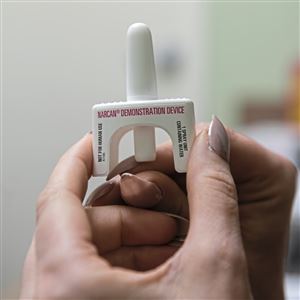At the bimonthly meeting of the Allegheny County Board of Health Wednesday afternoon, the nine-member committee discussed the trio of epidemics now hitting the Pittsburgh area: COVID-19, monkeypox and drug overdoses.
Reporting to a room of about 25 or so attendees in Downtown’s Allegheny County Courthouse, Dr. Debra Bogen, director of the Allegheny County Health Department, said that the positivity rate for COVID-19 infection this week is hovering around 19.9%, according to the results of 1,326 tests.
At the Board of Health meeting, however, Dr. Bogen said that those figures are less valuable now than they were earlier on in the pandemic.
The best picture of the scale of the virus’s spread now comes from wastewater data — scanning sewage for traces of SARS-CoV-2. Experts say that the method gives a fuller, population-level view of how the pandemic is progressing and can predict a wave of infections a week before symptoms and positive tests crop up.
“The wastewater [data] really do reflect well our cases, which I think is important since we no longer have good case data, because everyone’s testing at home, including me,” said Dr. Bogen.
The wastewater data, which the county has been collecting since November 2021, currently suggests low community spread, comparable to levels in March and April of this year, before they increased again for a few weeks in June.
Monkeypox cases in the county have risen to a total of six since the first case was confirmed on June 1st. According to Neil Ruhland, the county’s public health information officer, the Health Department has 60 doses of the JYNNEOS vaccine — at the moment, the only FDA-approved monkeypox shot on the market — reserved for “high-risk individuals,” although the department expects to receive more doses from the Pennsylvania Department of Health this week.
In her presentation to the committee, Dr. Bogen reiterated that monkeypox — the zoonotic disease spreading globally that presents in the form of skin lesions and rashes — is transmissible primarily from prolonged, intimate physical contact with an infected person.
Symptoms tend to begin within 7 to 14 days of exposure, but in some cases can incubate for as few as five or as many as 21 days. People experiencing symptoms, including fevers, chills, swollen lymph nodes, and the characteristic swollen, blister-like marks on the skin, are advised to get tested at a local healthcare provider.
After Dr. Bogen spoke, Otis Pitts, a deputy director at the Health Department, presented the findings of the county’s report on drug overdoses in 2021. According to the data, last year saw an increase of 31 overdose deaths in the county, up to 719 from the 688 recorded in 2020.
Dr. Donald Burke, dean emeritus of the University of Pittsburgh Graduate School of Public Health and a member of the board, said that those figures track for exponential growth in overdose deaths in the last 10 years, excluding 2016 and 2017, which saw anomalous year-over-year increases.
After far outpacing the rest of the country in 2015, Allegheny County now has the fourth highest rate of overdose deaths per 100,000 people nationwide, at 57.7, behind only Davidson, Tn., Franklin, Oh., and Philadelphia, the national leader with a rate of 68.3, according to the report.
The majority of overdoses in the county in 2021 were caused by lethal combinations of drugs. Eighty percent involved fentanyl, the powerful synthetic painkiller, 52% involved cocaine, and 37% involved fentanyl-like non-prescription opioids, Mr. Pitts said.
The percentage of overdoses involving heroin declined 20% last year, down from 42% in 2020. Between 2012 and 2015, heroin had been the substance most commonly responsible for overdoses in the county, eclipsed by fentanyl in 2016 and by cocaine and other opioids only last year.
Last year the overdose death rate for Black residents of the county, consistently the highest of any racial or ethnic in the past four years, increased by 21%, to 115 per 100,000 people, primarily from combinations of cocaine and fentanyl.
That figure is more than twice the rate for white residents of the county, recorded at 54 per 100,000 in 2021, roughly a 2% increase from 2020.
Zachary Groz: zgroz@post-gazette.com
First Published: July 13, 2022, 11:52 p.m.


















